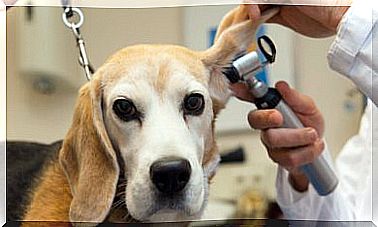Seasonal Allergy In Dogs: Everything You Need To Know

If we told you that this article is about seasonal allergy in dogs, what would you think? Although many would answer that it is a topic they know, others may indicate that they had no idea that allergic processes are possible in living beings other than humans.
In either case, it never hurts to expand your knowledge of different subjects, especially if you live with animals at home. Thus, you can be aware when you observe strange symptoms in the pet. That said, here are all the keys you should know about seasonal allergy in dogs.
What does seasonal allergy mean?
The allergy concept was introduced more than a century ago by Von Pirket. Specifically, it dates from 1906 and, according to the medical dictionary of the University of Navarra , this is defined as the situation of the organism or of the individual in which its reaction capacity is altered.
In other words, allergy supposes an alteration of the proper functioning of the organism. The person responsible for this physiological chain is called an allergen and it is a harmless substance for all members of the species, except for allergy sufferers. When the body recognizes the allergen, it activates its fighting systems.
Do dogs only suffer from seasonal allergies or are there other types of allergies?
Like the human being, it has been detected that animals close to man – such as dogs or cats – can suffer from allergies. Currently, there are different types of allergies, which are subdivided into 2 groups. These are as follows:
- Seasonal allergy: one that appears at specific times of the year — especially in spring and summer — during which symptoms are accentuated. Thus, the allergen is possibly some insect (mites), bacteria or environmental allergens, such as the famous pollen.
- Non-seasonal: if, on the contrary, the symptoms remain constant throughout the year, the allergic process is part of this group. In this case, it is likely that the allergen is related to substances with which the dog interacts in his day to day, such as food or an object in the environment that is present throughout the year.

Symptoms related to seasonal allergy
When assessing whether or not the dog has an allergy, it is essential to look at the symptoms that it manifests. It is also a good idea to observe the animal for a few days and note any clinical signs detected. However, some of the most common symptoms that will serve as a guide will be listed below:
- Atopic dermatitis: manifested by the appearance of hives or itching on the skin.
- Sores : infected, inflamed and red skin, due to bacterial proliferation from previous epidermal lesions.
- Deafness: caused by inflammation of the ear canals.
- Respiratory symptoms: sneezing, watery eyes, cough and mucus.
What can I do if my dog has a seasonal allergy?
Next, the steps that are appropriate to follow will be reflected if you suspect that the dog has a seasonal allergy. However, it is important to note that they are only indicative and that, without any doubt, it is best to always put yourself in the hands of a professional.
1. Go to the vet
If you think your pet may have a seasonal allergy, you should go to the vet. Although today the first thing is to search the Internet for symptoms that are detected, it is not advisable to implement the advice without supervision. Only the specialist will know how to confirm the diagnosis and tell the tutor the correct way to act.
In this way, the animal will be prevented from suffering and every guardian will know how to behave in the face of the clinical picture of his dog. Thus, both the human and the dog will be able to deal with the situation and adapt to it.
2. Check the feeding
Although it is repeated, this step is convenient to discuss with the veterinarian. It is not recommended to change the diet of the animal abruptly, since it is necessary to allow it to get used to this change. Despite this, this is one of the most recommended actions.
In particular, the consumption or incorporation of anti-inflammatory feed is normally recommended. These feeds are usually composed of low concentrations of carbohydrates or a low amount of grain. On the other hand, foods rich in fatty acids can be included, such as salmon or tuna oils.
3. Frequent baths
Another of the most common tips to combat seasonal allergy is to give the animal regular baths. Through the baths, the presence of allergens on the dog’s skin is reduced.
In addition, elements such as hypoallergenic or delicate skin shampoos can be incorporated into the grooming process. Finally, it is advisable to clean the legs – and also their owners’ shoes – when they return from the street and before they jump around the house. This prevents allergens from spreading around the house.
4. Medication
As for the medication, it should only be added to the routine if the veterinarian deems it appropriate. Normally, this approach is not common in dogs, but if necessary they can prescribe different antihistamines with which to combat allergy symptoms.
5. House cleaning
If we think about it, we act quite similarly whether it is the pet who suffers from the allergy or if it is another member of the family. Therefore, it is essential that home cleaning be done more frequently. Above all, you cannot forget passageways, such as corridors or hall .

Pets are another member of the family, but sometimes the guardian may not know how to interpret the animal’s messages. Therefore, it is necessary to be aware of behaviors such as sadness, loss of appetite, depressed mood or the appearance of any of the aforementioned symptoms.
If this is the case, as already stated, the vet is always the first step in dealing with the problem. In this way, the tutor will be able to reduce the symptoms of seasonal allergy in dogs and that the pet is comfortable and happy.









